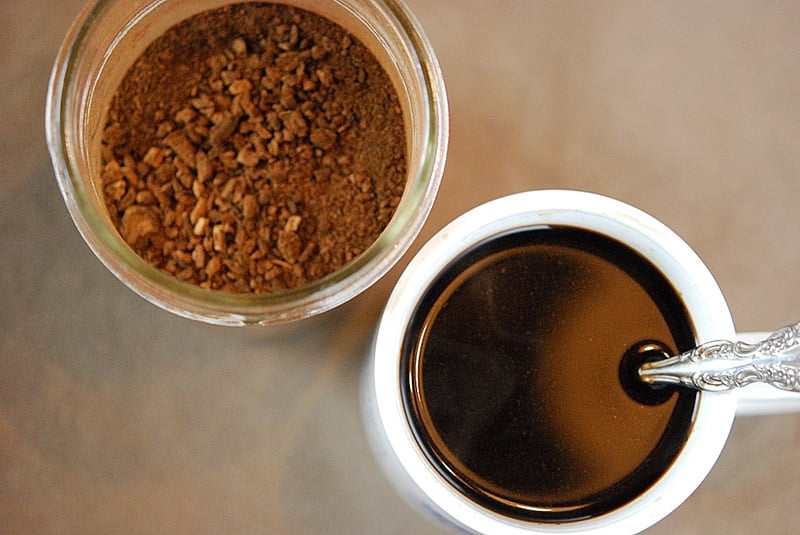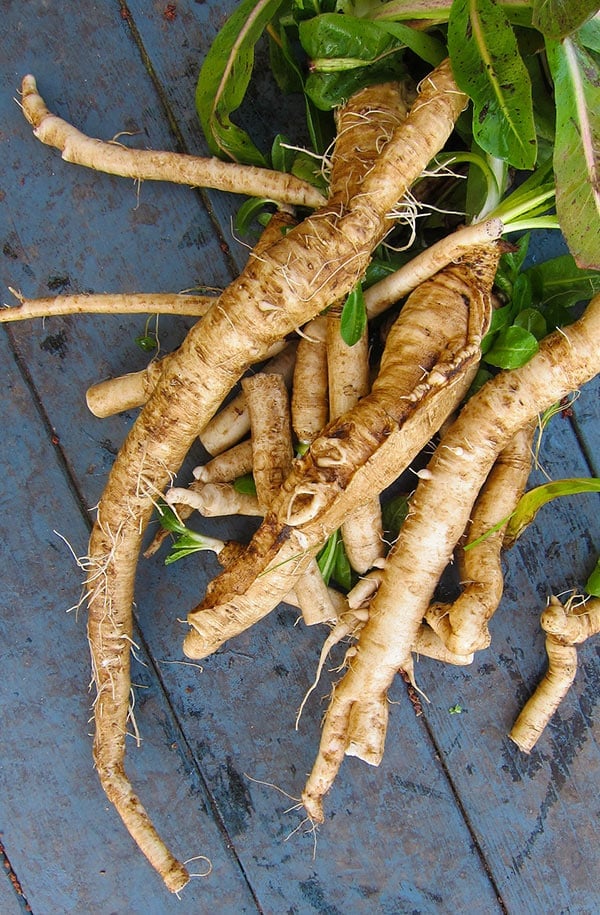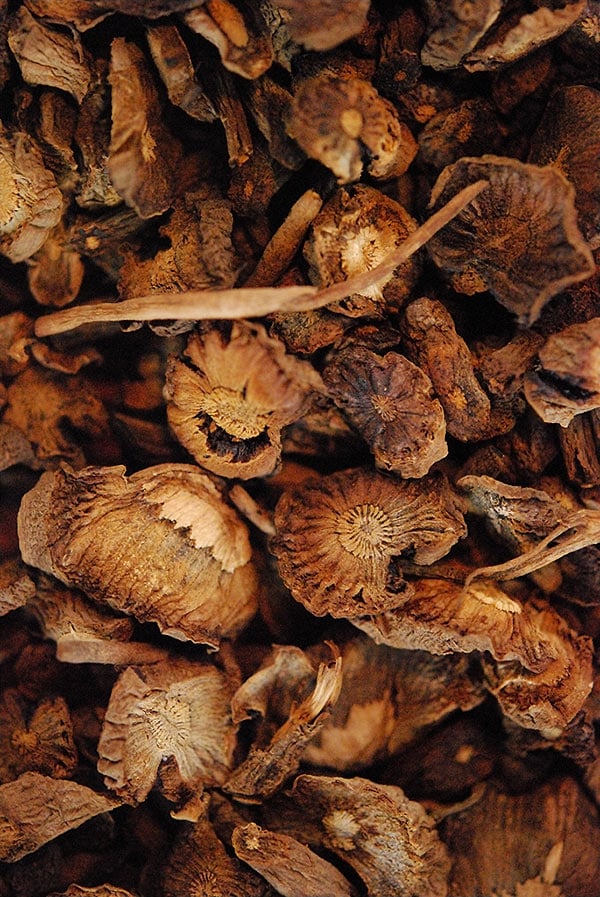As an Amazon Associate I earn from qualifying purchases.

For a time, my favorite coffee was New Orleans style, where the coffee is cut with roasted, ground chicory root. Chicory coffee is smooth, a little more acidic than normal coffee, with a taste and aroma similar to a mocha — and it makes a drink darker than the inside of a cow.
I used to Ozark it up even more by drinking it black, sweetened with molasses, not sugar. Definitely a manly drink, and probably the reason I have so much hair on my chest. I imagined lumberjacks or pioneers drinking this between cutting wood or fording wild rivers.
I was not in the habit of doing either, so I ultimately switched back to straight coffee. Actually I stopped because the canned chicory coffee I’d been buying grew pretty grim on my tastebuds over time; stale and dusty tasting. I never found anyone who made a premium version, so I left chicory coffee by the wayside.
I knew I could make my own by digging up the raggedy sailors — chicory is that weedy azure-blue flower that grows on a roadside near you. But I’d never bothered with it, as you need to dig in fall, and I only really notice this plant in summer when it’s flowering, or in early spring when I eat the greens.
But then I bought some “root chicory” seeds and planted them. Now I had absolutely no intention of making chicory coffee from them. I have a thing for crazy root vegetables, and it is my contention that if more locovores living in Northern climates grew a wider variety of roots, their winter menus would be far more interesting. I wanted to test this root out as a vegetable, so I planted it in my root bed next to the scorzonera I experimented with this year.
And then, as typically happens, life got in the way. I looked up and it was May already — while the chicory roots had not yet sent up flower stalks (except for one), they would be far too bitter and “hot” to eat as a veggie. Damn.
What to do with these things? I pulled one and was astounded at how large it was: A good 30 inches, with a base about two inches across. Christ, that’s a big root. And then I remembered my lumberjack coffee. But just how do you make chicory coffee?
I’d read a few sets of instructions that say just wash and dry the roots, then roast them in a moderate oven until “ready,” then break into pieces and grind into coffee-like grounds. I knew intuitively that this was false. I could not imagine breaking a root that was two inches broad into pieces small enough to not kill my grinder.

Other sets of instructions, mostly for making dandelion coffee (basically the same thing), call for slicing the roots into thin discs, then drying them, then roasting them, and then grinding them. This sounded more sane.
So I began slicing up the 20-or so large chicory roots I’d managed to pull. I ate a few raw, and they weren’t terrible: If something can manage to be sweet and bitter at the same time, these roots achieved that feat.
When I was doing this, it was 104°F outside. Not ideal oven drying weather, but perfect weather to dry things outside. And my “drying rack” of choice is the hood of my pickup. So I sat these sliced roots out in the sun, and they dried nicely in two days.
When it came time to roast the chicory, I found even more misleading instructions on the internet; yes, I know — misleading information on the internet?! Heavens! Everyone seems to say roast dandelion or chicory root in a 350°F oven for 10 to 15 minutes. Uh, yeah. You then have slightly warmer dried chicory roots. Nope, instead of 15 minutes, try 90 minutes, or even two hours. I might try 2 to 3 hours at a lower temperature next time.

I’d just like to say that even if you have no intention of actually drinking chicory coffee, it is worth roasting the roots this way. The whole house smelled wonderfully malty, chocolatey, warm. So lovely.
I let the roots cool overnight and ground them. Unfortunately they don’t seem to grind evenly, so I have powder mixed with chunks. But I use a press pot for my coffee, whose filter is enough to strain it all out.
I decided to brew myself a straight cup of chicory coffee. I put about a 1/4 cup into my press pot, the same amount I use for coffee, boiled some water and steeped the inky brew for about 5 to 8 minutes. I drank it black, with sugar.
Straight chicory coffee is some powerful stuff. it tastes like it is loaded with caffeine, but it isn’t. It looks a lot like motor oil, has that malty-chocolate aroma, a brighter acidity than coffee and a flavor I really am having trouble describing as other than with the cliche “earthy.” Guess that’s what I get for roasting a root.




Richard: These chicory roots are VERY slow to bolt, so that is a time-consuming option. Silfert, I bought my seeds here.
Hey, just the info I was looking for! I might have to give chicory another try. May I mention your blog in my garden column? I think folks would love to read about it.
Rachel: Yes, the advantage is that if you chop, dry, then roast, you get better control over the roasting color — if you grind fine before you roast, it can go from done to burnt really fast.
As for the seeds, look up a few comments and you can see I hotlinked to where I get mine.
I usually just grind the roots in a blender, and then bake them at around 250 for several hours. Is there any advantage to grinding the roots after they are roasted?
I love chicory, but I’m getting tired of digging it up in gravel along the roadside. Could you tell me where you got the chicory seed from?
We process 30 tons of chicory per day for coffee production and it really is good stuff. Here is some info you might find interesting related just to the root as that is what we deal with.
Chicory Root is considered a fine liver, gallbladder and spleen tonic. The herb is called a “cholagogue” or substance that promotes the production of bile and stimulates its flow from the gallbladder and bile ducts, and as such, is said to help purify blood and cleanse the liver and gallbladder …
The bitter principle in Chicory Root is believed to be beneficial for the glandular organs of the digestive system. The root is said to neutralize acid and correct acid indigestion, heartburn, gastritis, vomiting, upset stomach and lack of appetite, and Chicory Root has been approved by the German Commission E as a remedy for poor appetite and dyspepsia …
… Those with a very high fat diet experienced a remarkable decrease in blood cholesterol levels in time after taking Chicory Root, which may prove very helpful in cases of hardening of the arteries … The herb has a diuretic action that increases and promotes the flow of urine, which helps to cleanse the kidneys of toxins and remove them from the body.
It has been used to remove gravel, calcium deposits, and excess uric acid from the body, which helps to prevent gout and kidney stones … In addition, it has been used in poultices to reduce the inflammation of rheumatism and the pain of stiff and sore joints … Hope this was interesting to you all.
Lance
Hey Lance, Normally I do not edit comments, but this was way too long for me to run as is. I hope I got the gist of what you had to say. ~Hank
‘Alternative coffees’ have piqued my interest lately – so I’m glad you tried it. Sounds like it may be worth the bother.
Hank: chicory laced coffee reminds me of the summer I spent building roads in northern France (not at all romantic, sadly). See if you can dig up a nice recipe for brioche and those’ll pretty much be the gastronomic highlights from that summer.
best
Andrew
NTSC: Grind dried, roasted roots through a meat grinder? Really? I have never ground hard, dry things with a grinder before…
Coriander: I got them from the outfit Seeds From Italy, and the variety is called “Cicoria da radice di soncino.”
Molly: You can plant now and harvest around Thanksgiving…
Can one get bored with coffee? I know I am. I’ve heard of Chicory coffee before but had no idea you could grow your own root and make it.
i’m so planting chicory root seeds this autumn. can’t wait to grow some hair on my chest next year at this time.
Where did you get your root chicory seeds? I always mean to get out there in the fall and dig chicory roots, but I never get around to it. I’ve also heard that you can roast the seeds of that sticky weed, cleavers, to make a coffee substitute but it seems like you’d need quite a bit more than grows around my place.
Comment continued after computer decided IT wanted to post.
Grind it with a meat grinder with fine die, then a coffee grinder. You are looking for surface area.
Never had Postum but do remember it.
Chicory was used in the south during the civil war blockades as a coffee substitute.
Thanks, Garrett!
MK: Well I’ll be dipped: Had no idea Indians cut their coffee with chicory, too. Guess a billion of them can’t be wrong, eh?
Kindred: Leave it to the Tarheels to think about barbecue first and foremost. I’ll give it a shot with some venison I have in the freezer…
Elise: Come over soon and you can!
Nick: Yes, you can use parsnips. I’ve never done it, but other people do. Maybe I will do a three-way taste test: Dandelions, chicory and parsnips. Or I could just buy Postum. Anyone else old enough to remember it?
Wow, Hank! I have never heard of this, and is probably one of the most interesting ideas i have heard, pertaining to food. Can you use any type of root, first one that comes to mind is parsnip. I think I may just try this, parsnip seems like something that may carry a similar flavor profile. Let me know your thoughts.
Sweet Maria’s sells high quality chicory root, I got addicted to the stuff after trying the New Orleans Style coffee from Blue Bottle in SF.
https://www.sweetmarias.com/coffee.other.chicory.php
Oh, I would love to try some of that!
How about as a dry rub?
My family is from India, and virtually every one of the billion people on that subcontinent drinks coffee laced with chicory—and loaded with milk and sugar. (The brand of choice is Bru, which I’m sure doesn’t compare to the home-grown chicory variety you describe in such delicious detail, but it’s pretty good, at least for the amateur tastebud.) I always loved the coffee there, and didn’t figure out for awhile what the “magic” ingredient was that made it taste so different from the typical Starbucks latte. Three cheers for chicory!
I remember that beasty root. Also, very nice pictures – they have all the drama you could want. Great post. =)